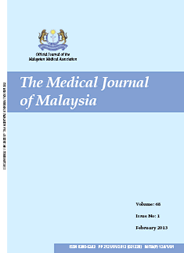MJM, Vol 70 Supplement 1 September 2015
Adaptation and validation of the Malay version of
Osteoarthritis Knee and Hip Quality of Life (OAKHQOL) questionnaire among knee
osteoarthritis patients: A Confirmatory Factor Analysis
*Department of Family Medicine, School of Medical Sciences, Health Campus, Universiti Sains Malaysia, Kubang Kerian, Kelantan, Malaysia, **Department of Nursing, School of Medical Sciences, Health Campus, Universiti Sains Malaysia, Kubang Kerian, Kelantan, Malaysia
ABSTRACT
Introduction: Health-related quality of life (HRQoL) that accurately reflects a patient’s experience with respect to specific disease is one of the important outcomes recommended for interventional study. The objective of this study is to evaluate the construct, convergent, criterion validity and reliability of the Malay-Osteoarthritis Knee and Hip Quality Of Life (OAKHQOL)
Methods: The English version OAKHQOL was adapted into Malay using forward and backward translation. A pilot study was done for face validity. For the psychometric properties, a cross-sectional study was conducted among 191 knee osteoarthritis patients. Patients completed the Malay-OAKHQOL and validated WOMAC questionnaires. Confirmatory analysis, reliability analysis, known group analysis and Pearson correlation test were performed to assess the psychometric properties of the Malay-OAKHQOL.
Result: The results showed that the original five-factor model with 40-items failed to achieve acceptable values of the goodness of fit indices, indicating poor model fit. A new five-factor model of 28 items demonstrated acceptable level of goodness of fit (Comparative Fit Index: 0.915, Tucker Lewis Index: 0.905, Incremental Fit Index: 0.916, Chi-squared/degree of freedom 1.953 and Root Mean Squared Error of approximation 0.071) indices to signify a model fit. The Cronbach’s alpha value for the new model ranged from 0.865 to 0.933. The composite reliability values of each construct ranged between 0.819 and 0.921, indicating satisfactory to high level of convergent validity. Pearson correlation coefficient between Malay-OAKHQOL and validated Malay version WOMAC showed adequate convergent validity. Known groups validity showed that there is statistical difference in body mass index, physical activity, mental and pain construct. There was also significant difference in the radiograph grading in the physical activity and pain construct.
Conclusion: The five-factor model with 28-item Malay-OAKHQOL demonstrated good degree of goodness of fit and was found to be reliable and valid to assess HRQoL in knee osteoarthritis patients.
